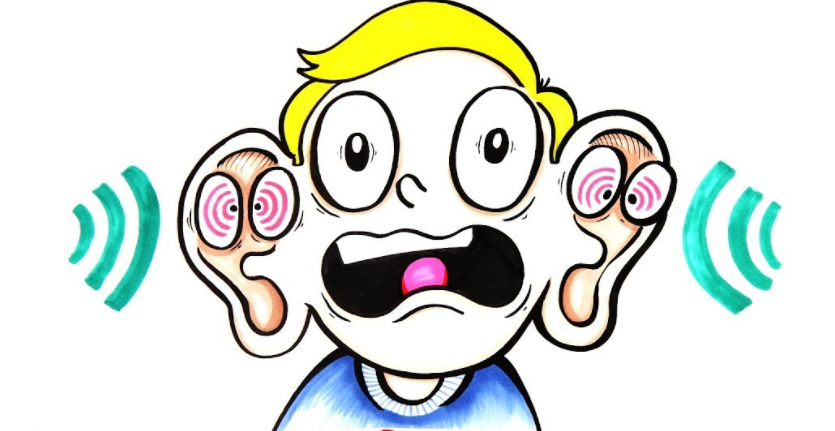any extra neural connections that could discern other sounds get eliminated from lack of use
任何可以識(shí)別其他聲音的額外神經(jīng)連接都會(huì)因?yàn)槿狈κ褂枚惶蕴?/div>
language gets lateralized in the brain
語(yǔ)言在大腦中具有單側(cè)性

so after a year we process it pretty much just with our left hemisphere
一年之后,我們僅僅用左腦就可以處理語(yǔ)言
so these phoneme differences can make it tricky to learn new languages
所以這些音素的差異會(huì)讓新語(yǔ)言的學(xué)習(xí)變得棘手
but don't worry there are plenty of chances for confusion in your native language to
但是不要擔(dān)心,在使用母語(yǔ)時(shí),我們經(jīng)常會(huì)混淆
take the McGurk effect, it's an illusion where people
以McGurk效應(yīng)為例,它是一種錯(cuò)覺(jué)——
think they hear two different sounds based on what someone's face is doing
基于人的面部表情,人們假設(shè)自己聽(tīng)到的是兩種不同的聲音
even though the audio is exactly the same
即使音頻完全一樣
like try this, watch one side of the screen for a couple seconds
就像這樣,看屏幕的一側(cè)幾秒鐘
and then the other and see if you hear a change
然后看另一側(cè),你是否聽(tīng)到了聲音的變化
bop bop-bop-bop, you really heard was just BA with a B
bop bop-bop-bop,事實(shí)上你聽(tīng)到的只是B開(kāi)頭的BA
but for most people that shifts from ba to fall with an F, depending on the mouth movements you're looking at
但大多數(shù)人以為是從BA轉(zhuǎn)變到FA,這取決于你觀察到的嘴巴動(dòng)作
so what happens if you don't have a person's face to look at
所以,如果不看一個(gè)人的面部表情會(huì)發(fā)生什么
like on a phone call, most of the time people use context to figure out ambiguous sounds
就像打電話一樣,大多數(shù)情況下,人們會(huì)使用語(yǔ)境來(lái)識(shí)別含糊不清的聲音
and one way to see this, is called the ganang effect
有一種方法,叫做加南效應(yīng)
in one study researchers artificially made a sound halfway between a D and a T
在一項(xiàng)研究中,研究人員人工制造了一種介于D和T之間的聲音
so most people couldn't tell the difference
大多數(shù)人都分辨不出二者的區(qū)別
when they put that sound at the start of a word with a SH at the end
當(dāng)把這種聲音放在單詞的開(kāi)頭,尾音是SH
most people think it's a D because Dash is an English word and Tash isn't
大多數(shù)人認(rèn)為是D,因?yàn)镈ash是英語(yǔ)單詞,而Tash不是
but if they put a SK after it, most people think it's a tea
但是如果在單詞的末尾加上SK,大多數(shù)人認(rèn)為這是茶
because task is an English word, even though it's the same ambiguous sound
因?yàn)閠ask是英語(yǔ)單詞,即使它的發(fā)音含糊不清
people's brains are so good at this that you can even replace the sound with a short burst of static
人類大腦在這方面非常擅長(zhǎng),以至于可以用短爆破音來(lái)代替
and this can be taken to some extremes
這可能會(huì)走入極端
for example listen to this, not a lot there right
比如,聽(tīng)聽(tīng)看這個(gè),聽(tīng)的不太清,對(duì)嗎
if you don't have any context to guide your expectation
如果你沒(méi)有任何語(yǔ)境來(lái)引導(dǎo)預(yù)期
it can be really hard to understand noisy sounds
嘈雜的聲音理解起來(lái)會(huì)很難
but if you know it's going to be someone saying, the football player lost a shoe
但如果有人說(shuō)足球運(yùn)動(dòng)員丟了一只鞋
it becomes easier to hear that message even though it's garbled, and it's super hard to unhear it
即使信息混亂,也很容易被聽(tīng)到,而且很難不被聽(tīng)到
it's hard to say exactly why these illusions happen
很難確切地說(shuō)這些幻覺(jué)為什么會(huì)出現(xiàn)
but neuroimaging studies have found that they tend to involve parts of the temporal lobe
但神經(jīng)影像學(xué)研究發(fā)現(xiàn),幻覺(jué)往往涉及部分顳葉
which is involved in hearing and language
顳葉涉及聽(tīng)力和語(yǔ)言
for example one fold of the temporal lobe called the superior temporal sulcus
例如顳葉的一個(gè)褶叫做顳上溝
seems to help integrate auditory and visual information
似乎有助于整合聽(tīng)覺(jué)和視覺(jué)信息
now even if you have context, there's the added fact that people can't hear all frequencies of sound equally well
如今,即使有背景信息,也會(huì)存在這樣的事實(shí),即人們聽(tīng)到各種頻率聲音的效果不是一樣好
most average people can hear frequencies from about 20 Hertz to 20,000 Hertz
大多數(shù)普通人能聽(tīng)到20~20,000赫茲頻率的聲音
but we hear the range near human voice is best
但是接近人聲范圍內(nèi)的聽(tīng)力效果是最好的
which are usually around 250 to 6,000 Hertz
該范圍通常在250~6,000赫茲
people need to crank really low and really high frequencies up to a higher amplitude
人們需要把極低和極高頻率聲音的振幅調(diào)至更高
in order to perceive them to be the same volume
才能感知兩個(gè)聲音相同的音量
you can illustrate this with an equal loudness curve
可以用等響曲線進(jìn)行說(shuō)明
this probably has to do with the anatomy of the inner ear and which frequencies can reverberate
這可能與內(nèi)耳解剖以及可以混響的頻率有關(guān)
through it the most to stimulate nerves
通過(guò)該頻率神經(jīng)的刺激度達(dá)到最高
although hearing is pretty complex
雖然聽(tīng)力很復(fù)雜
so remember that Yanni and Laurel recording that went viral
還記得風(fēng)靡一時(shí)的雅尼和勞雷爾的錄音嗎
the sound of Yanni was above 4500 Hertz, which is near the top of where our brains expect spoken language to be
雅尼的聲音超過(guò)4500赫茲,這個(gè)聲音接近我們大腦所期望的口語(yǔ)水平的頂端
some people just hear those frequencies a little better or worse
有些人聽(tīng)到的頻率很適合,有些人聽(tīng)到頻率的效果很差
the recording was of the word Laurel
這個(gè)錄音是勞雷爾的聲音
but when it's played back on devices that can't reproduce, lower frequencies is loud
但當(dāng)它在無(wú)法回放的設(shè)備上播放時(shí),低頻聲音會(huì)很大
some of those Yanni frequencies could be louder by comparison
相比之下,雅尼的頻率可能更大
so it made an ambiguous noise, like the sound halfway between D and T that you could use context to make sense of
所以它發(fā)出了一種介于D和T之間模棱兩可的聲音,可以用語(yǔ)境來(lái)理解
and like the Shoeless football player
就像光腳的足球運(yùn)動(dòng)員
lots of people found they could change what they heard just by focusing their brains on one word or the other
許多人發(fā)現(xiàn),只要把大腦集中在一個(gè)或另一個(gè)單詞上,聽(tīng)到的內(nèi)容就會(huì)改變
basically brains are really weird and amazing
從根本上說(shuō),大腦的確有些不可思議
so thanks for exploring them with us here on scishow psyche
感謝收看本期的心理科學(xué)秀
to learn about ways to trick your other senses check out our video about the rubber hand illusion
學(xué)習(xí)如何欺騙你的其他感官,請(qǐng)觀看我們的橡膠手錯(cuò)覺(jué)視頻
and don't forget to go to youtube.com/scishow psyche and subscribe
別忘了登陸youtube.com/scishow psyche網(wǎng)站訂閱我們的節(jié)目哦












